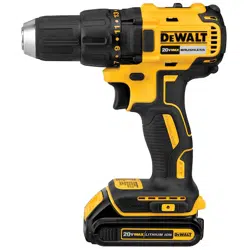Loading ...
Loading ...
Loading ...

ENGLISH
9
Installing and Removing the Battery Pack
(Fig. G)
NOTE: For best results, make sure your battery pack is
fullycharged.
To install the battery pack
10
into the tool handle, align the
battery pack with the rails inside the tool’s handle and slide
it into the handle until the battery pack is firmly seated in
the tool and ensure that it does notdisengage.
To remove the battery pack from the tool, press the release
button
11
and firmly pull the battery pack out of the tool
handle. Insert it into the charger as described in the charger
section of thismanual.
Fig. G
10
11
Proper Hand Position (Fig. H)
WARNING: To reduce the risk of serious personal injury,
ALWAYS use proper hand position as shown.
WARNING: To reduce the risk of serious personal injury,
ALWAYS hold securely in anticipation of a sudden
reaction.
Proper hand position requires one hand on the main handle
12
and one hand on the battery pack.
Fig. H
12
Drilling (Fig. I)
NOTICE: If drilling thin material, use a wood “back-
up” block to prevent damage to the material.
1. Select the desired speed/torque range using the gear
shifter to match the speed and torque to the planned
operation. Turn the collar
3
to the drill symbol.
2. Use sharp drill bits only. For MASONRY, such as brick,
cement, cinder block, etc., use carbide-tipped bits rated
for percussion drilling.
3. Always apply pressure in a straight line with the bit. Use
enough pressure to keep drill biting, but do not push
hard enough to stall the motor or deflect the bit.
4. Hold tool firmly with both hands to control the twisting
action of the drill. If model is not equipped with side
handle, grip drill with one hand on the handle and one
hand on the battery pack.
WARNING: Drill may stall if overloaded causing a
sudden twist. Always expect the stall. Grip the drill
firmly to control the twisting action and avoid injury.
5. IF THE DRILL STALLS, it is usually because it is being
overloaded or improperly used. RELEASE TRIGGER
IMMEDIATELY, remove drill bit from work, and
determine cause of stalling. DO NOT depress TRIGGER
ON AND OFF IN AN ATTEMPT TO START A STALLED
DRILL — THIS CAN DAMAGE THE DRILL.
6. To minimize stalling or breaking through the material,
reduce pressure on drill and ease the bit through the
last fractional part of the hole.
7. Keep the motor running when pulling the bit back out
of a drilled hole. This will help prevent jamming.
Fig. I
SCREWDRIVING
Fig. J
DRILLING
3
Screwdriving (Fig. J)
1. Select the desired speed/torque range using the gear
shifter to match the speed and torque to the planned
operation.
2. Turn the torque adjustment collar
3
to the desired
position.
NOTE: Use the lowest torque setting required to
seat the fastener at the desired depth. The lower the
number, the lower the torque output.
3. Insert the desired fastener accessory into the chuck as
you would any drill bit.
4. Make some practice runs in scrap or on unseen areas of
the workpiece to determine the proper position of the
torque adjustment collar.
5. Always start with lower torque settings, then advance
to higher torque settings to avoid damage to the
workpiece or fastener.
MAINTENANCE
WARNING: To reduce the risk of serious personal
injury, turn unit off and remove the battery pack
before making any adjustments or removing/
installing attachments or accessories. An
accidental start-up can causeinjury.
Cleaning
WARNING: Blow dirt and dust out of all air vents with
clean, dry air at least once a week. To minimize the risk
of eye injury, always wear ANSI Z87.1 approved eye
protection when performingthis.
Loading ...
Loading ...
Loading ...
